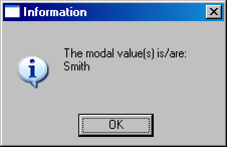MODAL Function
The MODAL function provides a measure of central tendency that identifies the element or elements of a data set that repeats most frequently, and more frequently than another element of the data set. Unlike AVERAGE and MEDIAN, the MODAL function can be applied to non-numeric data. The following table shows how MODAL works on various data sets:
Data Set | AVERAGE | MEDIAN | MODAL |
|---|---|---|---|
{1, 2, 3} | 2 | 2 | None |
{1, 1} | 1 | 1 | None |
{1,1,2} | 1.333 | 1 | 1 |
{1,1,2,10} | 3.5 | 1.5 | 1 |
{1, 1, 2, 2} | 1.5 | 1.5 | None |
{1, 1, 2, 2, 3} | 1.8 | 2 | 1 and 2 |
{'John', 'John', 'Mary'} | N/A | N/A | 'John' |
{'1-jan-2003','1-jan-2003', '2-jan-2003'} | N/A | N/A | '1-jan-2003' |
This function has the following syntax:
Array = modal(list = array[, modecount = byref(integer)]
[, ignorecase = integer])
[, ignorecase = integer])
Arguments | Data Type | Description |
|---|---|---|
list | Array of Object | Lists of any of the following data types: FloatObject, IntegerObject, MoneyObject, DecimalObject, DateObject, LongVcharObject, StringObject. All elements must be of the same type. |
modecount | Integer | Returns the number of instances of the modal value or values in the data set. |
ignorecase | Integer | Valid values are FALSE and TRUE. This parameter is ignored unless the data type is StringObject. If set to TRUE, comparisons are case-insensitive. Default: FALSE |
This function returns:
• Array of Object—Array containing the modal element or elements of the list. The array must be of the same type as the array passed to MODAL.
• Null—If list is NULL or empty
Example—MODAL function:
/*
** Identify the most frequently occurring surname in an HR database
*/
initialize()=
declare
array_name = array of stringobject;
array_results = array of stringobject;
dbso = DBSessionObject;
msg = varchar(256) not null;
n = integer not null;
ret = integer not null;
enddeclare
** Identify the most frequently occurring surname in an HR database
*/
initialize()=
declare
array_name = array of stringobject;
array_results = array of stringobject;
dbso = DBSessionObject;
msg = varchar(256) not null;
n = integer not null;
ret = integer not null;
enddeclare
{
/*
** Connect to the database
*/
ret = dbso.Connect(database = 'xxxxxxxx::testdb');
CurFrame.DBSession = dbso;
/*
** Connect to the database
*/
ret = dbso.Connect(database = 'xxxxxxxx::testdb');
CurFrame.DBSession = dbso;
/*
** Load the surnames in the roster into an array
*/
n = 1;
select lastname as array_name[n].Value
from hr_table
{
n = n + 1;
};
** Load the surnames in the roster into an array
*/
n = 1;
select lastname as array_name[n].Value
from hr_table
{
n = n + 1;
};
/*
** Pass the array of surnames to the Modal function
*/
array_results = modal(list = array_name);
** Pass the array of surnames to the Modal function
*/
array_results = modal(list = array_name);
/*
** Loop through the results to report all modal values
*/
if array_results.AllRows = 0 then
msg = 'No modal value';
else
msg = 'The modal value(s) is/are: ';
for n = 1 to array_results.LastRow do
msg = msg + HC_NEWLINE;
msg = msg + array_results[n].Value;
endfor;
endif;
** Loop through the results to report all modal values
*/
if array_results.AllRows = 0 then
msg = 'No modal value';
else
msg = 'The modal value(s) is/are: ';
for n = 1 to array_results.LastRow do
msg = msg + HC_NEWLINE;
msg = msg + array_results[n].Value;
endfor;
endif;
/*
** Report the results
*/
message msg;
/*
** Disconnect from the database
*/
dbso.Disconnect();
}
** Report the results
*/
message msg;
/*
** Disconnect from the database
*/
dbso.Disconnect();
}
Sample output is shown in the following illustration:

Last modified date: 12/20/2023